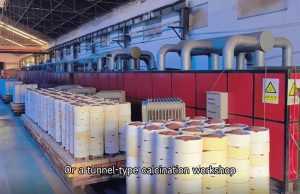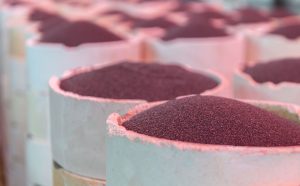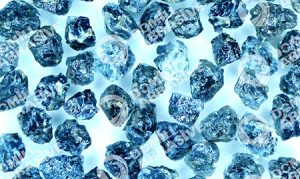Home / News & Blog / 3 Common Alumina Abrasive Grains Reprocessing Methods and Performance Improvement Comparison
Alumina abrasives are widely used in metal processing, grinding, cutting and other industrial fields. In particular, due to their high hardness and wear resistance, they have become the preferred material for many high-precision grinding. However, the original alumina abrasive grains often require further processing to improve their performance and meet different processing requirements. Reprocessing can improve the grains morphology, size distribution, hardness, toughness and other characteristics, there by enhancing their performance under different working conditions.
As a supplier with 30 years of production experience, we will explore several common alumina abrasive particle reprocessing methods in depth, and analyze the performance improvements brought by these processing methods through actual comparison.
The heat treatment (calcination treatment) can improve the hardness, toughness and wear resistance of alumina abrasive particles by high-temperature heating. The specific process is as follows:
The abrasive is directly calcined at a high temperature of 800-1300℃ for 2-4 hours, taken out and cooled, and can be used. If the temperature is high, some abrasives will have a small amount of sintering phenomenon, and they need to be broken and sieved before use.


Performance Improvement
The fine cracks formed by multiple impacts during the granulation process of the abrasive are sintered at high temperature, which increases the strength of the single particle due to sintering during the manufacturing process of the abrasive.
Increase the hydrophilicity of the abrasive and improve the adsorption of the abrasive on the binder, so that the adhesion of the abrasive to the substrate is enhanced with the help of the binder.
Eliminate dark cracks, improve the refinement of the abrasive crystal, eliminate impurities in the abrasive, eliminate the electrostatic induction generated by the abrasive particles during the processing, reduce the magnetic content of the abrasive, and improve the cleanliness, hydrophilicity, wear resistance and toughness.
After calcination, the microhardness of brown fused alumina abrasive can be increased by 10%, the toughness by 10%, the hydrophilicity by 3.5 times, the grinding amount by 3%, and the durability by 30-50%.


The main characteristics of white fused alumina abrasive after calcination are: prominent edges and corners, sharp, uniform grain shape, high strength, good self-sharpening, low grinding heat generation, and the bonding strength between the abrasive and the emery cloth is greatly improved after calcination, the sand removal rate is greatly reduced, and the low use of the abrasive belt is improved.
After calcination, the abrasive has poor fluidity, poor moisture resistance, and bonded particles.
Applicable scenarios
Suitable for industrial applications that need to work under high temperature or high pressure conditions, such as: grinding of high-speed steel, processing of alloys with higher hardness, etc.
Mechanical processing changes the shape of alumina abrasive particles through mechanical force. Commonly used technologies include crushing, screening, ball milling, etc. The specific processes are as follows:
Crushing: Use a crusher to crush larger abrasive particles into the required particle size.
Screening: Use a vibrating screen to sort abrasive particles into different particle sizes to ensure that the particle size range of each particle meets the specific application requirements.
Ball milling: Use a ball mill to grind the particles and adjust the shape and particle size of the particles to obtain a more uniform distribution.
Advantages and Disadvantages
Advantages: After the abrasive is shaped, the number of isotropic shapes increases, the number of flakes and needles decreases, and the mechanical strength, toughness, bulk density, and wear resistance of the abrasive are increased.
Disadvantages: The sharpness of the abrasive decreases after mechanical processing. Tiny broken particles may be introduced during the mechanical processing process, affecting the uniformity of the particle size distribution. At the same time, more dust pollution may be generated.
Applicable scenarios
Widely used in abrasives that require precise particle size and shape, especially suitable for high-precision processing and precision grinding.
The surface modification method enhances the wear resistance, cutting performance and heat resistance of the alumina abrasive particles by adding functional coatings or materials on the surface of the alumina abrasive particles. The specific process is as follows:
Metal salt coating-currently commonly used abrasive plating treatment
The abrasive is soaked in a metal salt solution with a concentration of 0.1%-1.0% for about 30 minutes, then taken out and dried, and the dried abrasive is calcined to 500℃ for about 30 minutes, and can be used after cooling. For example, the brown corundum treated with 0.5% ferrous sulfate, and then calcined at 800℃, the grinding efficiency of the abrasive belt can be increased by 4-20%. Commonly used metal salts include ferrous sulfate, nickel acetate, nickel oxide, copper sulfate, copper sulfate-borax, ferric nitrate, cobalt nitrate, etc. There are also coated abrasives that are adhered to the abrasive binder with materials such as ferric oxide or ferric oxide, calcined to 500-1100℃ for half an hour, and can be used after cooling, which also has obvious grinding effects.
Treatment with ceramic liquid
Ceramic liquid with components such as feldspar, clay, or limestone is applied to the surface of the abrasive and sintered at high temperature (about 1000-1300℃) to coat the surface of the abrasive with a thin layer of ceramic material to facilitate the bonding of the abrasive and the binder, thereby improving the durability of the sanding belt.
Treatment with resin liquid
The abrasive is soaked in a resin mixture composed of liquid phenolic resin and a small amount of metal oxides such as ferric oxide, ferric oxide or titanium oxide. It can be taken out and dried for about 30 minutes before use. Since the resin liquid has good permeability and can penetrate into the tiny pores of the abrasive, it increases the bonding of the abrasive to the binder and improves the durability of the sanding belt. Since metal oxides are added to the resin liquid, the heat dissipation of the abrasive grains in the sanding belt is increased, which is conducive to improving the efficiency of the sanding belt.
Treatment with coupling agents such as silane
Coupling agents are widely used. Silane, also known as organosilicon, is a special compound that has both inorganic and organic properties generated by chemical reaction between silicon and organic genes. Therefore, after the abrasive is coated with silane, it is beneficial to the combination of the abrasive and the binder. There are two ways of coating: one is to directly coat the silane liquid on the surface of the coated abrasive. The most ideal and effective thickness of the coating is a single molecule thickness, which is more difficult to operate; the other simple method is to directly add silane to the adhesive liquid, but the effect of this method is not as good as the former.
Performance improvement
After surface treatment, aluminum oxide abrasive can improve the surface roughness of abrasive particles and increase hydrophilicity, so as to improve the bonding force between abrasive particles and binder.
Taking ABR28 (Coated Brown Fused Alumina) as an example, the abrasive is a red cube with high stacking density and regular abrasive particles. Its product toughness, hydrophilicity, cleanliness, magnetic content and hardness are significantly improved after high-temperature plating, and it has the advantages of strong bonding and good heat dissipation. It is mainly used to manufacture high-end coated abrasives for polishing hardwood boards with high requirements and heavy-duty belt grinding of metals.

Taking WAK15 (Coated White Fused Alumina) as an example, the abrasive is plated with high-quality white corundum abrasive, which has the characteristics of slightly lower toughness, high purity, excellent self-sharpening, strong grinding force, low heat generation, high efficiency, acid and alkali corrosion resistance, high temperature resistance, and good thermal stability. It is mainly used in the manufacture of high-end resin and rubber abrasives. The abrasives made with it are suitable for grinding high carbon steel, high-speed steel and hardened steel, etc., and have the advantages of fast cutting and high grinding ratio.

Advantages and Disadvantages
Advantages: Improves the versatility of abrasives and is suitable for special grinding needs.
Disadvantages: The modification process may lead to increased costs and requires high-precision equipment to control the thickness and uniformity of the coating.
Manufacturers should select the most suitable reprocessing method based on:
Application Requirements: For high-intensity grinding, heat-treated grains offer enhanced durability, while surface-modified grains provide superior bonding for coated abrasives.
Desired Grain Properties: If sharpness is essential, mechanical processing might not be ideal, whereas heat-treated grains can achieve high hardness without sacrificing cutting ability.
Budget and Production Capacity: Surface modification requires additional investment, so choosing it for high-value, high-performance applications ensures better ROI.
The main purpose of reprocessing fused aluminum oxide abrasive particles is to improve their hardness, cutting efficiency, wear resistance and high temperature resistance. Different reprocessing methods have different application scenarios and effects. Heat treatment can improve the hardness and crushing resistance of particles and is suitable for high-intensity grinding tasks; mechanical processing is suitable for high-precision grinding and can accurately control the particle size.